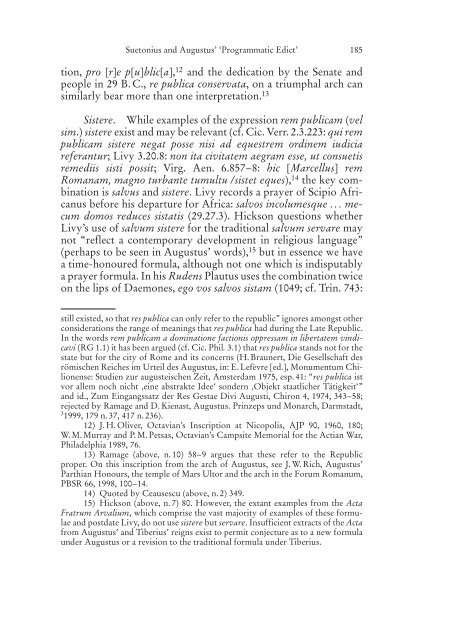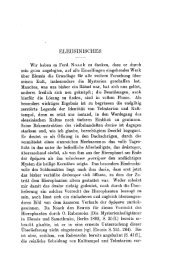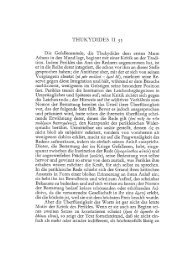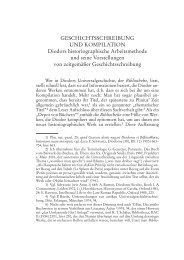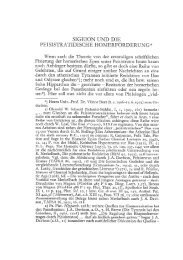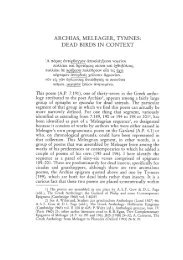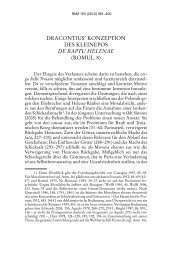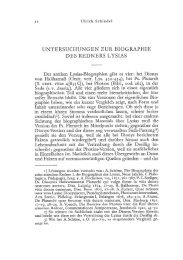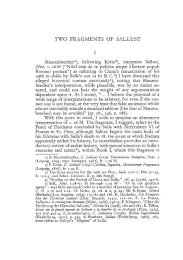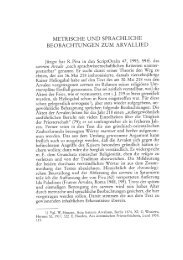VIRGILIO E STESICORO Una ricerca sulla Tabula Iliaca Capitolina *
VIRGILIO E STESICORO Una ricerca sulla Tabula Iliaca Capitolina *
VIRGILIO E STESICORO Una ricerca sulla Tabula Iliaca Capitolina *
Erfolgreiche ePaper selbst erstellen
Machen Sie aus Ihren PDF Publikationen ein blätterbares Flipbook mit unserer einzigartigen Google optimierten e-Paper Software.
Suetonius and Augustus’ ‘Programmatic Edict’<br />
tion, pro [r]e p[u]blic[a], 12 and the dedication by the Senate and<br />
people in 29 B. C., re publica conservata, on a triumphal arch can<br />
similarly bear more than one interpretation. 13<br />
Sistere. While examples of the expression rem publicam (vel<br />
sim.) sistere exist and may be relevant (cf. Cic. Verr. 2.3.223: qui rem<br />
publicam sistere negat posse nisi ad equestrem ordinem iudicia<br />
referantur; Livy 3.20.8: non ita civitatem aegram esse, ut consuetis<br />
remediis sisti possit; Virg. Aen. 6.857–8: hic [Marcellus] rem<br />
Romanam, magno turbante tumultu /sistet eques), 14 the key combination<br />
is salvus and sistere. Livy records a prayer of Scipio Africanus<br />
before his departure for Africa: salvos incolumesque . . . mecum<br />
domos reduces sistatis (29.27.3). Hickson questions whether<br />
Livy’s use of salvum sistere for the traditional salvum servare may<br />
not “reflect a contemporary development in religious language”<br />
(perhaps to be seen in Augustus’ words), 15 but in essence we have<br />
a time-honoured formula, although not one which is indisputably<br />
a prayer formula. In his Rudens Plautus uses the combination twice<br />
on the lips of Daemones, ego vos salvos sistam (1049; cf. Trin. 743:<br />
still existed, so that res publica can only refer to the republic” ignores amongst other<br />
considerations the range of meanings that res publica had during the Late Republic.<br />
In the words rem publicam a dominatione factionis oppressam in libertatem vindicavi<br />
(RG 1.1) it has been argued (cf. Cic. Phil. 3.1) that res publica stands not for the<br />
state but for the city of Rome and its concerns (H. Braunert, Die Gesellschaft des<br />
römischen Reiches im Urteil des Augustus, in: E. Lefèvre [ed.], Monumentum Chilionense:<br />
Studien zur augusteischen Zeit, Amsterdam 1975, esp. 41: “res publica ist<br />
vor allem noch nicht ‚eine abstrakte Idee‘ sondern ‚Objekt staatlicher Tätigkeit‘”<br />
and id., Zum Eingangssatz der Res Gestae Divi Augusti, Chiron 4, 1974, 343–58;<br />
rejected by Ramage and D. Kienast, Augustus. Prinzeps und Monarch, Darmstadt,<br />
3 1999, 179 n. 37, 417 n. 236).<br />
12) J. H. Oliver, Octavian’s Inscription at Nicopolis, AJP 90, 1960, 180;<br />
W. M. Murray and P. M. Petsas, Octavian’s Campsite Memorial for the Actian War,<br />
Philadelphia 1989, 76.<br />
13) Ramage (above, n. 10) 58–9 argues that these refer to the Republic<br />
proper. On this inscription from the arch of Augustus, see J. W. Rich, Augustus’<br />
Parthian Honours, the temple of Mars Ultor and the arch in the Forum Romanum,<br />
PBSR 66, 1998, 100–14.<br />
14) Quoted by Ceausescu (above, n. 2) 349.<br />
15) Hickson (above, n. 7) 80. However, the extant examples from the Acta<br />
Fratrum Arvalium, which comprise the vast majority of examples of these formulae<br />
and postdate Livy, do not use sistere but servare. Insufficient extracts of the Acta<br />
from Augustus’ and Tiberius’ reigns exist to permit conjecture as to a new formula<br />
under Augustus or a revision to the traditional formula under Tiberius.<br />
185


